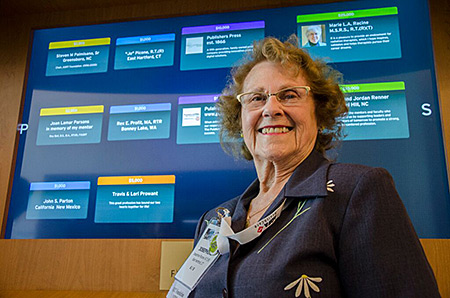Dec. 17, 2015
 A favorite quote in my family is “A life is not important except for the impact it has on other lives.”
A favorite quote in my family is “A life is not important except for the impact it has on other lives.”
This sentiment is a large part of why I began supporting the work of the ASRT Foundation: The Foundation has a direct impact on the lives of R.T.s, students and patients. Over the years, I kept this quote in mind to help drive my actions, both personally and professionally.
I began my career in radiography back in 1948 at the Massachusetts School of Physical Therapy and Medical Technology in Boston. At the time, I was 17 and could not apply to be a nurse, so my uncle, who was a doctor, encouraged me to go into radiology. He said it was an interesting field with a lot of potential, and he was right!
I have seen a lot of changes to the profession over the years. There was a time when I had to turn on a sign that read “DO NOT LOITER — X-RAYS MAY BE IN PROGRESS” to protect people from radiation. I remember working early on in a hospital that performed fluoroscopy before the use of lead gloves became standard practice. Years later, I saw a radiologist I had worked with, and he had lost two fingers and part of his hand because of it.
I remember when the six-minute radiographic processor came out, then was upgraded to the three-minute processor, followed by 90-second solutions. These processors were a blessing — before them, we had to hang up the pieces of film and direct a fan to dry them. The spacing had to be just right: The films needed to dry, but no two films could touch each other. If that happened, nothing in this world could separate them. Today, nearly everything is digital.
Naturally, the equipment has evolved during the course of my career. The Lateral Lumbar Spine, with a 25-mA Westinghouse, required an eight-second exposure time. The huge and cumbersome “Wiggleator,” used for children’s fluoroscopy and chest imaging, won a 1954 scientific award. The pneumoencephalgram chair turned patients almost upside down to acquire the images. I’m glad our technology has improved since these devices were used.
As I witnessed these changes in the emergency room and clinic over the years, I have been active in professional societies and I saw how important it was that we support each other in the profession. I served as secretary of the Massachusetts Society of Radiologic Technologists in 1955 and helped with the ASRT conference in Boston that year.
In 1957, I moved with my husband and two sons to Connecticut, where I joined the Connecticut Society of Radiologic Technologists. I had the privilege of chairing several of the society’s committees, serving as the editor of its publication and as vice president and chairman of the legislative committee. I was part of the committee that worked for years to pass the Radiation Safety Act, which requires radiologic technologists to be certified and licensed in Connecticut. The act became law in 1993.
Through the years, my family grew to include five sons and one daughter, though sadly we lost one of our sons. After my last child was born, I went to work at the city hospital.
I was in the emergency room at St. Francis Hospital & Medical Center in the trauma radiology department for 33 years. This challenging and rewarding experience led me to volunteer with Connecticut’s Capitol Region Medical Reserve Corps about 10 years ago. I’m still imaging and loving it!
The field of radiologic sciences made it possible for me to care not only for my patients but also for my family. My husband, Angelo, became ill and died in 1983 when our youngest child was only 13. The profession allowed me to do something I love while helping my family through tough times.
As my late husband used to say, “We may not have it all together, but together we have it all”. I think this applies not only to my family but also to everyone working in the radiologic sciences. That is one of my main motivations for supporting the ASRT Foundation. The profession of radiologic technology is important to me, and it’s exciting to see what’s in store for the field. The ASRT Foundation has built a great resource for R.T.s, students and the profession. I want to see others jump on board to support what the Foundation is working to accomplish for us all.
This article was originally published in ASRT Scanner, Vol. 48, No.1, Page 22. Josephine Picone, the article's author, is an ASRT Foundation Celebration Campaign donor.